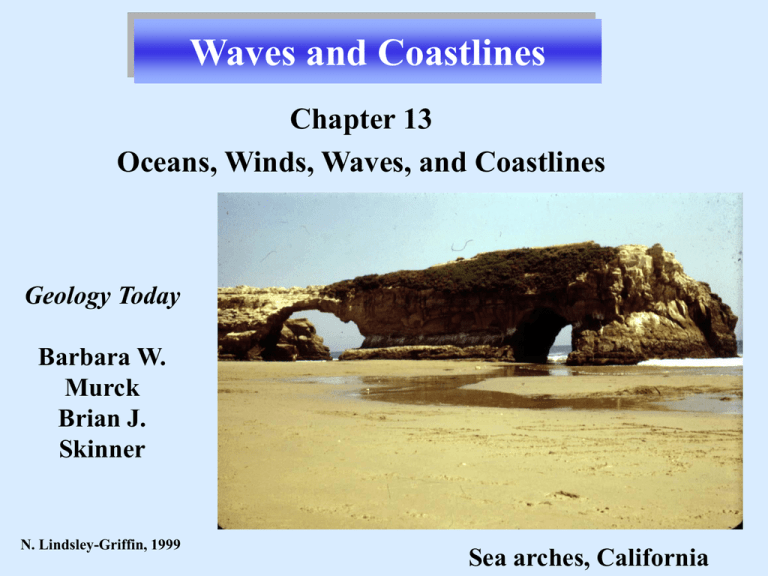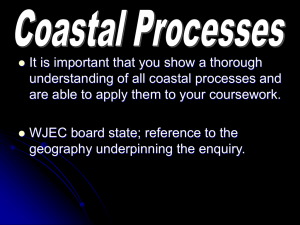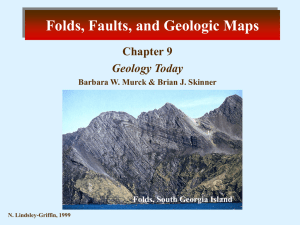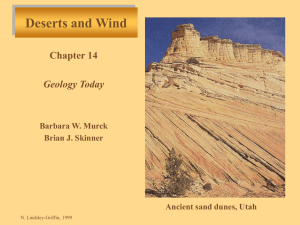coasts
advertisement

Waves and Coastlines Chapter 13 Oceans, Winds, Waves, and Coastlines Geology Today Barbara W. Murck Brian J. Skinner N. Lindsley-Griffin, 1999 Sea arches, California Ocean Waves Houghton Mifflin 1998; N. Lindsley-Griffin, 1999 Wave Properties Ocean Waves A single particle at the surface moves in a circular path as each wave passes. Motion decreases to nothing, at a depth equal to one-half the wavelength. N. Lindsley-Griffin, 1999 Waves Near Shore Waves “feel” bottom As bottom shallows, waves are forced into smaller space. Their shape distorts as the front slows down. Waves Near Shore Breakers form as the wave oversteepens and topples N. Lindsley-Griffin, 1999 Waves Change Near Shore Fig. 13.16, p. 387 N. Lindsley-Griffin, 1999 Erosion by Waves The part of a wave that “feels” bottom first, slows down. The part still in deeper water moves faster, and the entire wave line curves, forcing wave energy towards headlands. Houghton Mifflin 1998; N. Lindsley-Griffin, 1999 Erosion by Waves Headlands are eroded by waves refracted towards them. Less resistant rock (like shale) will erode faster. More resistant rock (like sandstone) will be left behind as sea stacks. N. Lindsley-Griffin, 1999 Erosion by Waves Sea stacks Oregon coast Sea cliffs, sea stacks northern California coast N. Lindsley-Griffin, 1999 Waves move away from the prevailing wind direction, approaching coastlines at an angle. N. Lindsley-Griffin, 1999 Transport of Sediments As waves approach shore at an angle, they generate a current parallel to shore called the longshore current. Longshore Current N. Lindsley-Griffin, 1999 Wind Transport of Sediments Waves run up shore at an angle Water runs straight back along steepest slope Sediment particles are transported along shore in a zigzag path Net motion = beach drift N. Lindsley-Griffin, 1999 Transport of Sediments Longshore current and beach drift combine to transport large quantities of sediment parallel to the shore Fig. 13.18, p. 389 N. Lindsley-Griffin, 1999 Sediment transport by longshore current N. Lindsley-Griffin, 1999 Human Interference Groins - Sand is deposited by longshore current on the up-current side; eroded by wave action on the downcurrent side. J. Wiley, J.R. Griffin, N. Lindsley-Griffin, 1999 Human Interference Erosive effect of wave action decreased by breakwater; beach builds out. Asymmetry of beach indicates longshore drift direction from bottom to top. J. Wiley, J.R. Griffin, 1999 N. Lindsley-Griffin, 1999 Transport of Sediments Water carried onshore must find a path back to sea Rip currents flow out to sea along narrow channels and broad sheets J. Wiley; N. Lindsley-Griffin, 1999 Rip currents transport sediments out to deeper water, can create dangerous undertows. J. Wiley; N. Lindsley-Griffin, 1999 Waves Near Shore Wave-cut bench and sea cliffs, Oregon Breaking waves apply force in a narrow plane Erosion is greatest in a knife-edge right at water level Effects: wave-cut benches undermined sea cliffs sea arches and caves sea lion perches N. Lindsley-Griffin, 1999 Sea lions, La Paz, Mexico Waves Near Shore Wave-cut notches and sea caves represent the early stage of undermining that eventually results in mass-wasting collapse of cliffs and sea stacks Sea Cave, California Wave-cut notch, New Brunswick N. Lindsley-Griffin, 1999 Waves Near Shore J. Wiley; N. Lindsley-Griffin, 1999 Coastal Landforms Wavecut bench at water level, uplifted wavecut bench - north of San Francisco, California N. Lindsley-Griffin, 1999 Coastal Landforms Fig. 13.19, p. 390 N. Lindsley-Griffin, 1999 Two wave-cut benches, with headlands and beaches (Tongue Point, New Zealand) Coastal Landforms Modern sea stack N. Lindsley-Griffin, 1999 Tectonically uplifted wave-cut bench with fossil sea stacks (north of San Francisco, CA) Fossil sea stack Coastal Landforms Houghton-Mifflin, 1998; N. Lindsley-Griffin, 1999 Coastal Landforms Sea arches form where waves cut through headlands. Eventually wave action and mass wasting will remove the top of the arch and leave sea stacks behind. N. Lindsley-Griffin, 1999 Coastal Landforms Longshore drift deposits sand in a southpointing spit at the mouth of the Russian River, northern California Coastal Landforms A tombolo is a spit or bar that connects an island or sea stack to the mainland. Big Sur coast, California Coastal Landforms J. Wiley, J.R. Griffin, 1999 Tombolo seen from space Coastal Landforms A baymouth bar blocks the mouth of a bay. (Oregon coast) Human Interference Houghton Mifflin 1998 N. Lindsley-Griffin, 1999 Beach houses attacked by hurricane, North Carolina






